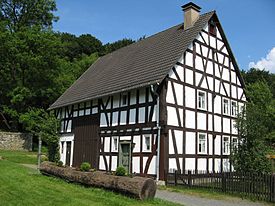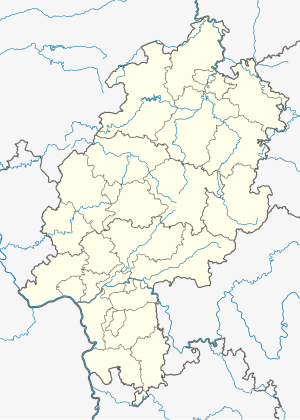Weilburg Wildlife Park
| Weilburg Wildlife Park | ||
|---|---|---|
| surface | 93 hectares | |
| Animal species | 22 species | |
| Visitor numbers | 111,000 visitors in 2010 | |
| organization | ||
| Sponsorship | Hessen-Forst State Office, Wildlife Park Management Weilburg Forestry Office | |
| Funding organizations | Association of friends and sponsors of the Tiergarten wildlife park | |
|
The farmhouse from Dillhausen houses a small museum |
||
|
|
||
Coordinates: 50 ° 29 ′ 19 ″ N , 8 ° 19 ′ 39 ″ E
The wildlife park Tiergarten Weilburg is a wildlife park in the Taunus , near the Hessian city of Weilburg , in the district of Hirschhausen . In 2010 it had around 111,000 visitors. Partner is the Forestry Office Weilburg under the sponsorship of the Hessian State Office Hessen-Forst .
Geographical location
The wildlife park is located within the eastern Hintertaunus in the Taunus nature park, about 900 m southwest of the village church in the Hirschhausen district of Weilburg . The wooded area of the park extends at an altitude of between 270 and 320 m .
investment
In addition to the numerous enclosures on an area of 93 ha, which mainly show native animal species, the zoo includes several ponds and a network of paths around six kilometers long. Cap oaks up to 400 years old are part of the park's tree population, which was planted according to plan, but is modeled on a natural mixed forest.
The restaurant "Zum Tiergarten" (Hessenhaus) is located in a Westerwald farmhouse from Langendernbach . A farm museum is located in a 200 year old farmhouse from Mengerskirchen-Dillhausen , which was moved to the park in 1972. In addition to day guests, conference participants are also catered for there. Various play equipment for children is available in the park.
To the living in the Deer Park zoo animals include next Dam - muffle - deer - red -, wild boar , ducks and geese also rear cattle , elk , otters , Skudden , Ibex , Przewalski's horses and wolves , wild cats , brown bears and lynx .
Over 200 species of mushrooms live in the wildlife park, some of which are on the red list . A mushroom nature trail provides information about the importance of this species for the forest ecosystem.
history
The complex goes back to the zoos of the counts and princes from the house of Nassau-Weilburg . To the east of Weilburg, in the area of today's zoo, Count Albrecht von Nassau kept fallow deer that had been imported from Holland as early as 1590 . Count Johann Ernst had the area expanded into a hunting park from 1685 to 1688, enclosed with a wooden fence and three ponds with a total area of around 1.5 hectares.
Under Prince Karl August von Nassau-Weilburg , this fence was replaced in 1732 by a 3.8 kilometer long and more than two meter high stone wall. It is still preserved today and encompasses 92 hectares of land. The inhabitants of the surrounding villages were used to build the wall. Ramps were set up on the outside of the wall at deer crossing so that the animals could enter the park but not get out again. Karl August also had a hunting lodge built by 1736, which was destroyed in a fire in 1916. The walls and castle were built according to the plans of the princely gardener Johann Martin Petri.
From 1816, the zoo was initially no longer used as such, but like a conventional forest according to the requirements of forestry. In 1970 it was reopened as a zoo under the direction of the Hessian state forest administration.
Further information
A report on the history of the Wildlife Park Tiergarten Weilburg, published posthumously for Wikipedia, written (after 1998) by Siegfried Müller, who was born in the Tiergarten in 1916:
As early as 1590, Count Albrecht von Nassau and Saarbruecken kept fallow deer east of Weilburg, in the area of the later zoo. This is closely linked to the history of the Counts of Nassau Weilburg. Two decades after the 30-year war, Count Johann Ernst von Nassau-Weilburg let the square forest and meadow area of one square kilometer (100 ha) be pacified. The enclosure initially consisted of a plank fence. Fallow deer were kept for hunting reasons. In the interior of the zoo, alleys and aisles were created to enable a hunt by horse behind a hunt pack. (Parforce hunt still practiced in England today.)
Provisional hunting tents initially provided accommodation for Count Johann Ernst and his entourage on the hunt. Around 1686 a house with 12 beds, a stable, a barn, a pleasure garden and a kitchen building were built. The "zoo-keeper" who was responsible for the hunting facilities lived here. At the same time he was the tenant for the agricultural areas in and around the zoo. This is how the existence of the later Tiergarten lease began.
In 1688 a pond was created for fish farming by damming the stream flowing through the zoo. I remember that after the First World War, the Helbig brewery from Weilburg got the ice for cooling the beer here. The wall around the zoo was built during the reign of Count Johann Ernst, i.e. before 1719. There are no files on the construction of the wall, but you can be sure that it was built in compulsory labor, so without any burden on the court finances.
From 1732 to 1736 the successor, Fuerst Karl August, had a stately hunting and pleasure house built near Frankfurter Strasse, which later served as a forester's house and burned down in 1916. After that, a new forester's house was built at this point, in which the district manager lives today. In addition to forestry activities, he is also responsible for looking after the animals housed in the zoo.
With the construction of this hunting and pleasure house, a connecting road from Weilburg to the pleasure house was built from 1732 to 1734, today's "Frankfurter Strasse". It connected the summer residence of the ruler Karl August, the "Windhof" near Weilburg, with the zoo. The already mentioned Lease Farm Tiergarten was rebuilt by Prince Karl August in 1733. Karl August moved his stud to the zoo, so that from now on horse breeding was given great attention.
In 1808, one of Nassau's first school-based veterinarians, Johann Peter Lieser from Wiesbaden-Sonnenberg, was appointed to the Tiergarten State Stud. He also became a Hofgutspaechter. This was the beginning of the Lieser family's lease in the zoo. The term of the lease ran for over 120 years and ended in 1934 with the death of my uncle Wilhelm Priester. The mentioned veterinarian Johann Peter Lieser was my great-great-grandfather on my mother's side. His son, Friedrich Wilhelm August Ernst Lieser, succeeded him and was a veterinarian in the zoo from 1846 to 1889. I myself was born in 1916 in the Tiergarten farm. My grandmother still lived alone in this leasehold, which was then demolished in 1936 due to a lack of construction. In its place a half-timbered house from Dillhausen was erected.
Until 1866, when Nassau was incorporated into Prussia, forest use was in the foreground, hunting played a subordinate role. But fallow deer was still there. The Rhenish Horse Breeding Association maintained a foal pasture until about 1935, which was filled with foals. A foal keeper from Hirschhausen was in charge and lived in a room in the foal stable, which is still there today. In 1969, the Hessian Forest Administration decided to create a modern wildlife park within the wall, in which native wild species can be observed in as natural an environment as possible. There are 400-year-old hat oaks and beeches here. Today's game population consists of aurochs, tarpan, breeds of animals that have long been extinct. Przewalski's horse, Exmoor pony, wisent, otter, lynx, ibex, red deer, fallow deer, sika deer, mouflon, roe deer, wild boar and, since 1998, elk. On and around the three ponds there is a lively and colorful picture due to the water birds. In order to interest visitors in mushrooms, the mostly inconspicuous helpers in the natural balance, a mushroom nature trail was laid out in 1992 and 1993. It is hardly a question of edible mushrooms, but rather important decomposers and converters for the forest floor and the rotting wood. Almost all forest trees have a connection to the subterranean mycelium system of certain fungi via their root system. At the box office you can buy an excellently equipped booklet about the mushroom nature trail in the wildlife park.
literature
- Randolf Fügen: Highlights in Central Hesse . 1st edition. Wartenberg Verlag, Gudensberg-Gleichen 2003, ISBN 3-8313-1044-0 .
Web links
- Official website of the wildlife park
- Unofficial website for Weilburg an der Lahn - with lots of information and pictures about the wildlife park
Individual evidence
- ↑ Map services of the Federal Agency for Nature Conservation ( information )
- ↑ The above report is in the possession of the descendants.




